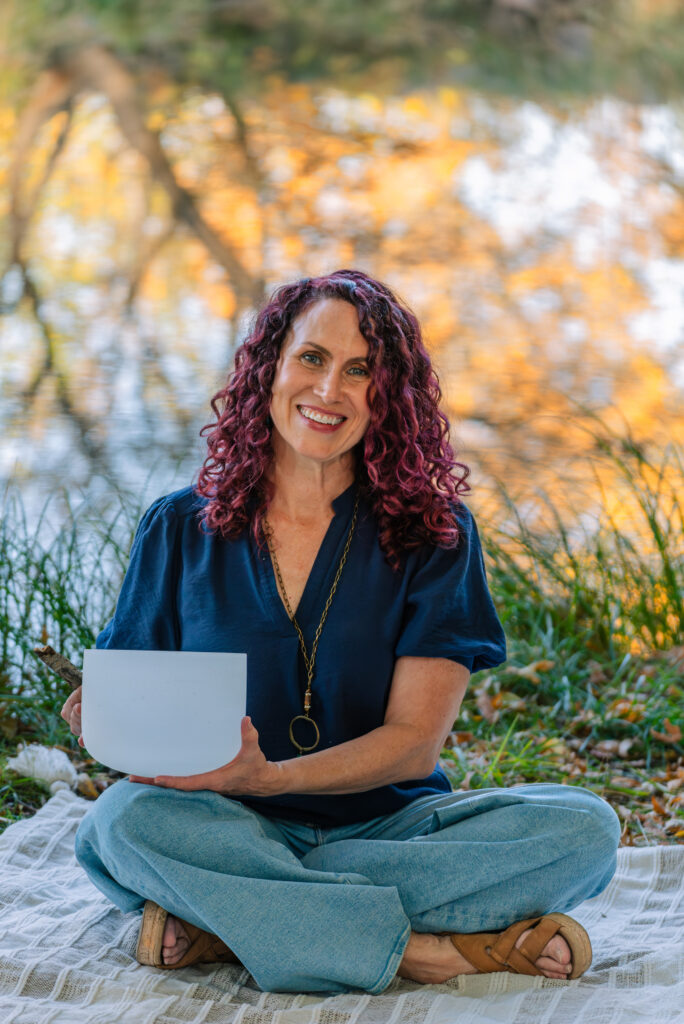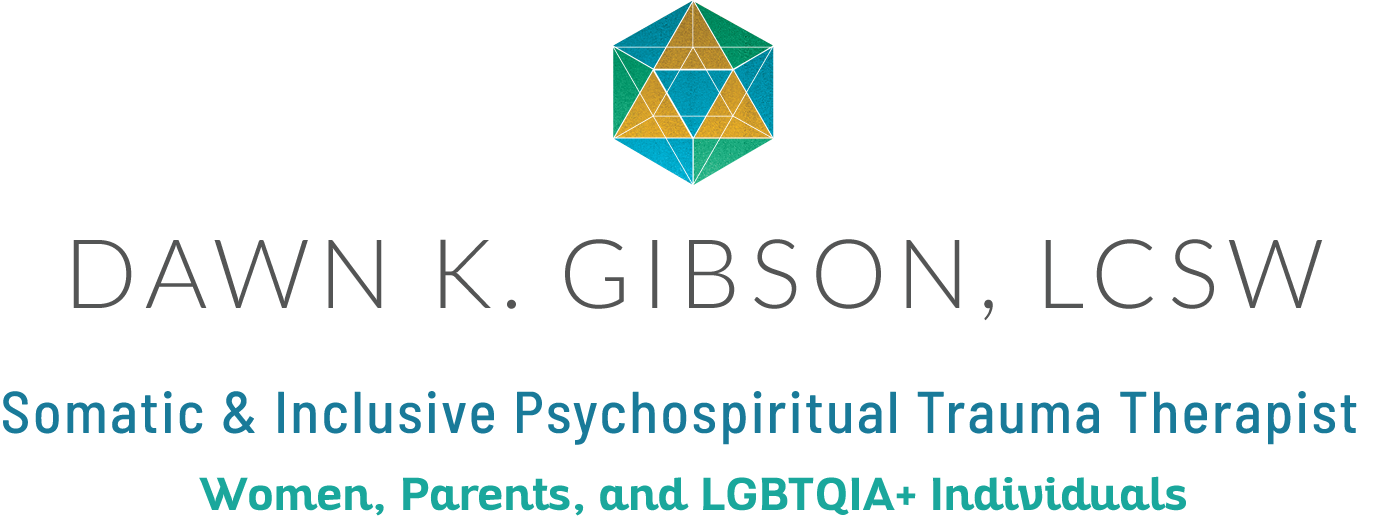Approach
how i work and why it matters to me
The essence of true healing manifests in a space and relationship with a psychotherapist who helps you feel safe enough to come back to the office again and again, and continue to engage in the difficult work of sharing vulnerably and processing trauma and pain.
Healing from trauma or childhood wounds doesn’t have to feel heavy and hard. In fact, shedding the old parts of yourself and coming into deeper awareness of who you are can be a gentle, uplifting, and an empowering rebirth, as you become more aligned with your authentic self and purpose. As you heal through connecting with your physical, emotional, and spiritual bodies, you will find parts of yourself that you didn’t know existed.
I’m Dawn K. Gibson, LCSW, a Somatic & Inclusive Psychospiritual Trauma Therapist of 25 years. I seek to create a safe, sacred, uplifting physical and energetic space to help you gently heal trauma, childhood wounds, and unconscious patterns, so you can transmute pain into power and live authentically, confidently, peacefully, and in alignment with your soul, path, and purpose.
I am most effective in supporting clients when I combine clinical frameworks such as attachment, polyvagal, and experiential theories, (and more), with complementary spiritual (non-religious) practices and divination tools, such as guided angel visualizations, energy practices, oracle or tarot cards (and more).
With over two decades of clinical experience, I’ve found that incorporating complementary practices with evidenced-based practices helps clients feel lighter, brighter, and grounded at the end of sessions after processing trauma or other painful experiences.
I’ve supported hundreds of clients—across diverse cultures, races, abilities, sexualities, identities, and neurodivergent experiences—through a wide range of challenges, including, but not limited to, healing trauma, childhood wounds, and unconscious patterns.
I approach my work from an anti-oppressive, equitable, social justice, anti-racism, neurodivergent, LGBTQIA+ affirming, feminist, anti-diet, body, and fat liberation perspective. Discrimination is not tolerated, and I am committed to ongoing personal and professional growth, and unlearning.
If my approach to psychotherapy and healing resonates with you and you are ready to get started, or if you’re curious and have questions, please feel free to email me.
For those who live in CO or TX and are seeking psychotherapy, or for those who live elsewhere and are seeking life or parent coaching, reach out for a free phone consultation to determine fit. infoatdawnkgibsondotcom

Mind-Body Psychotherapy
Mind-body psychotherapy, otherwise known as somatic or body-centered psychotherapy, is an approach that views each person as whole in mind, body, spirit, and emotions. When I provide therapy, I see you as more than your “issues” or diagnoses. I see you as a whole human being with strengths and challenges who is doing the best you can.
Because trauma and emotional issues are stored in our brains and bodies, mind-body psychotherapy is powerful in helping you heal trauma, anxiety, depression and more.
When we experience a traumatic, emotional, or stressful event, these events impact our brains and central nervous systems. This impact changes our bodies and brains (physical pain, anxiety).
While talk therapy is useful in making meaning of our difficult experiences, we must also go through the body to release and heal trauma. Much of our emotional pain is unconscious, so we utilize your body’s wisdom to get to the root of your issues, to bring the unconscious into consciousness and heal.
Techniques I use in mind-body psychotherapy include but aren’t limited to: mindfulness, meditation, relaxation techniques, guided imagery, curiosity, body scans, and exploring physical sensations.
Mindfulness
Mindfulness means noticing, with self-compassion, what’s happening in the present moment-without self-criticism, self-judgment, or trying to change it. Mindfulness is a somatic practice that literally changes your brain!
Mindfulness promotes trauma healing, improves focus, and positively impacts mental, emotional, and physical health, Mindfulness lowers stress and anxiety, increases self-awareness, compassion, empathy, and emotional regulation and also helps create positive relationships.
Self-Connection
Taking time out of our day to connect with ourselves is so important. It may be as simple as asking, “What do I need in this moment right now?” It could be taking a few breaths and noticing how you’re feeling. It could also include meditating to connect more deeply with Spirit/Universe/Source/fill in the blank, and yourself, to gain access to your intuition, desires, messages, and next steps.
Meditation on a regular basis promotes nervous system regulation, inner peace, and connection to your inner guidance. I recognize not everyone can meditate due to mental health issues and trauma. In fact, meditation is not advised for those who have unhealed trauma due to the risk of retraumatizing yourself and going into a freeze response. This is something we can work out together.
Somatic Practices
As you develop awareness of the mind-body connection, we utilize experiential tools and practices to help you release the wounds that remain stored in your body from past events. This helps you begin to connect more deeply to yourself, your desires, and your intuition, as you break the cycle of behaviors, feelings, and relationships tha tkeep you stuck, so you can live the life you desire.
A few somatic practices I may use include dance, qoya, yoga poses, body scans, breathwork, and Emotional Freedom Technique (EFT tapping).
Holistic/Divination Healing Practices
I offer a holistic unconventional integrative approach specific to each client or group. I will teach you or incorporate tools and practices that will help you along your healing journey.
Some of these practices include, but are not limited to energy work, intuitive guidance, guided imagery, angel meditations/visualizations, specific rituals, ceremonies, oracle or tarot cards, crystals, cord pulling, and more.
Core Routines
Throughout our time together in our collaborative therapeutic relationship, I will encourage you to identify and engage in core routines. I learned this term from my mystic mentor and friend, Lindsay Pera. She identifies core routines as “the elements of your daily practice that you seek to observe regularly.”
Core routines involve a deeper level of self care and other practices to help you feel grounded and keep you aligned with your intuition, truth, and purpose in your daily life and beyond. I will introduce self-empowerment tools that may enhance your core routines.
Interpersonal Connection
Connection is a basic human need and can be received through the context of relationships with one another. During our 1-1 time together, we’ll create a collaborative therapeutic relationship, where you are welcome as you are, you won’t be judged, and you can bring all parts of yourself into the room as I support you to heal.
During any groups I may facilitate, you’ll circle and connect with me and other humans in a confidential setting. you’ll be with peers who will accept you, share vulnerably with you, laugh and cry with you, celebrate and support you.
We are a connection-deprived society so there is nothing like connecting with one another and circling in a sacred space with other humans who are also seeking deeper and more meaningful relationships as everyone heals.
Qoya Dance Practices
Qoya (pronounced Koyah), created by Rochelle Schieck, has had an incredible impact on my life and the lives of others. Qoya is a feminine dance practice that reminds us we are wise, wild, and free.
Although I don’t teach the full Qoya class, I may draw from Qoya and incorporate some of the dance practices into our 1-1 or group work together.
Sometimes we just need to shake our bodies to release stress or tension and dance with our sadness, anger, fear, joy or our heart’s desires!
Nature Connection
As Dr. Shefali said, “Nature is the antidote to disconnection.” Nature has a profoundly positive impact on our mental health. Smartphones, computers, and television have caused more disconnection than ever. Whenever possible, I incorporate nature into our work together.
According to many research studies, connection with nature may decrease anxiety, sadness, fatigue, stress, cortisol levels, and anger. Nature may improve concentration, energy, sense of well-being, and connection with self and others.
I’m so grateful to have access to and a view of water and trees from my office window that you will get to enjoy, too!
